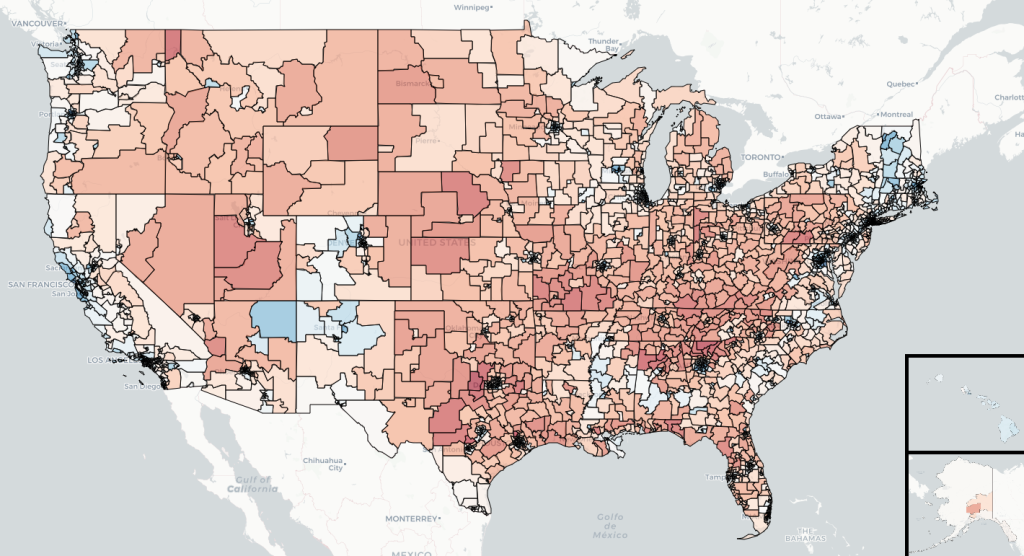What Are We?
ElectionCord is a liberal-leaning organization aimed to help candidates, as well as assist local and state parties run campaigns efficiently.
What Can ElectionCord Bring To Your Campaign?
Our Philosophy and Principles
ElectionCord has 3 main guiding principles that we believe in when running a campaign, and they are:
1. Know the demographics in your district. People of the same demographic tend to vote similarly, and while they are not a monolith, it can be helpful to know who lives in your district. For instance, people without a BA tended to shift towards Trump in 2024 more than BA holders. Before starting a campaign, you need to know the territory.
2. Stick with the basics. When it comes to elections, deep analysis is not worth the payoff. When it comes to messaging, we don’t believe that every last phrase should be tested to death. It comes off as robotic and devoid of personality. That’s not to say that you shouldn’t be careful with crafting your message, but we’re here to help you stick to simple, focused messaging.
3. Focus on your campaign, not positioning yourself as moderate or progressive. We don’t fall on one side of the moderate or progressive divide within the Democratic party. While we think that certain policies are more popular with certain demographics than others, it’s not the end of the world. What we care about is trying to fit your district. As an example, if you are running in a very urban, young district, people there will have different priorities from those in suburban or rural districts.
ElectionCord’s 100K District Project
The origin of the 100K District Project actually came with a disdain for the current size of the House of Representatives. We wanted to create a map of the US with a higher number of districts to be more representative of all Americans. We decided on one representative for every 100,000 people, which is small enough to be more representative, but still a manageable number of seats. When making them, we had a few guidelines we tried to keep to, which were:
- Avoid splitting counties
- Don’t split precincts/block groups at all
- Keep districts reasonably compact
- Group together people of similar demographics when possible, specifically ethnicity, ancestry, and education.
The result is this:

When we were done, we realized that the 100K Districts actually have a lot of other uses, even if they aren’t obvious at first glance. They could be used to analyze the US and its demographics, and even a statewide and nationwide strategy for a political party.
We believe that the 100K Districts are the ideal way to analyze the US as a whole. They are much better than states and counties, because 100K Districts are of equal population, while counties and states are not. Some urban counties are also so big that just one look at their demographics doesn’t necessarily tell the full story. As an example, LA County is absolutely massive; 44 states have a smaller population than it. That being said, it’s also diverse, with many different kinds of communities living there.

LA County as a whole is about 48% Hispanic, but knowing where Hispanic communities are is very helpful for campaigning. Additionally, we find the districts to be more palatable than precincts or block groups. In California, we have 395 100K Districts, while there are tens of thousands of precincts in the state.
We have a few different purposes and projects using the 100K Districts. We have information about how each district has voted at the presidential level since 2016, and demographic information, which we call the Tabula America Project, which consists of ethnicity, education, income, and more. They are all on our website, electioncord.com. We are also able to average out the districts easily, to create a baseline for how the average demographic votes (e.g., majority Hispanic areas, areas that the average household makes above 100K a year).

This is just an example of what the 100K District averages look like. These demographic estimates are in line with other polling-based analyses done for the 2024 Election.
We also keep track of approval polling, so we are able to apply that to our 100K District map, so we can roughly track what any area thinks about Trump, the 2026 congressional vote, and even what people’s most important issue is.
State/Nationwide Campaigns
Our methods can also be applied if you’re a state or national party, and are juggling multiple elections at once. We wrote about “The 100K Strategy” in a previous article, where you can use the 100K districts as administrative districts of sorts.
History
ElectionCord started out in the lead-up to the 2024 US elections as just a Discord server, hence the name Election(Dis)Cord. After the election didn’t go the way we wanted though, we looked around and saw opportunity within the Democratic coalition. We saw how the party operated during the national campaign, and that there were clear inefficiencies with how they spent money, time, and resources. With our anger, or as a coping mechanism perhaps, we wanted to throw our hat in the ring in some way, and that’s when we decided to expand to more than just a Discord page. We came up with the 100K District Project, the Tabula America Index, and started posting on social media. We still weren’t sure though if we wanted to go down the front-facing analysis section, or more of a consulting, back-end role. What we eventually decided on, was to primarily focus on consulting, with some analysis for the public on ElectionCord.com, to spread our ideas and concepts.
Contact Us
If you’re a liberal or progressive candidate or organization looking to run a modern, effective campaign, we’re here to help. Reach out to us on X (Twitter), Bluesky, E-Mail, or Discord, and let’s discuss how we can support your efforts.
X (Twitter): @ElectionCord
Bluesky: @electioncord.com
Email: Electioncord@gmail.com
Discord: https://discord.gg/YkJ4KxrC
